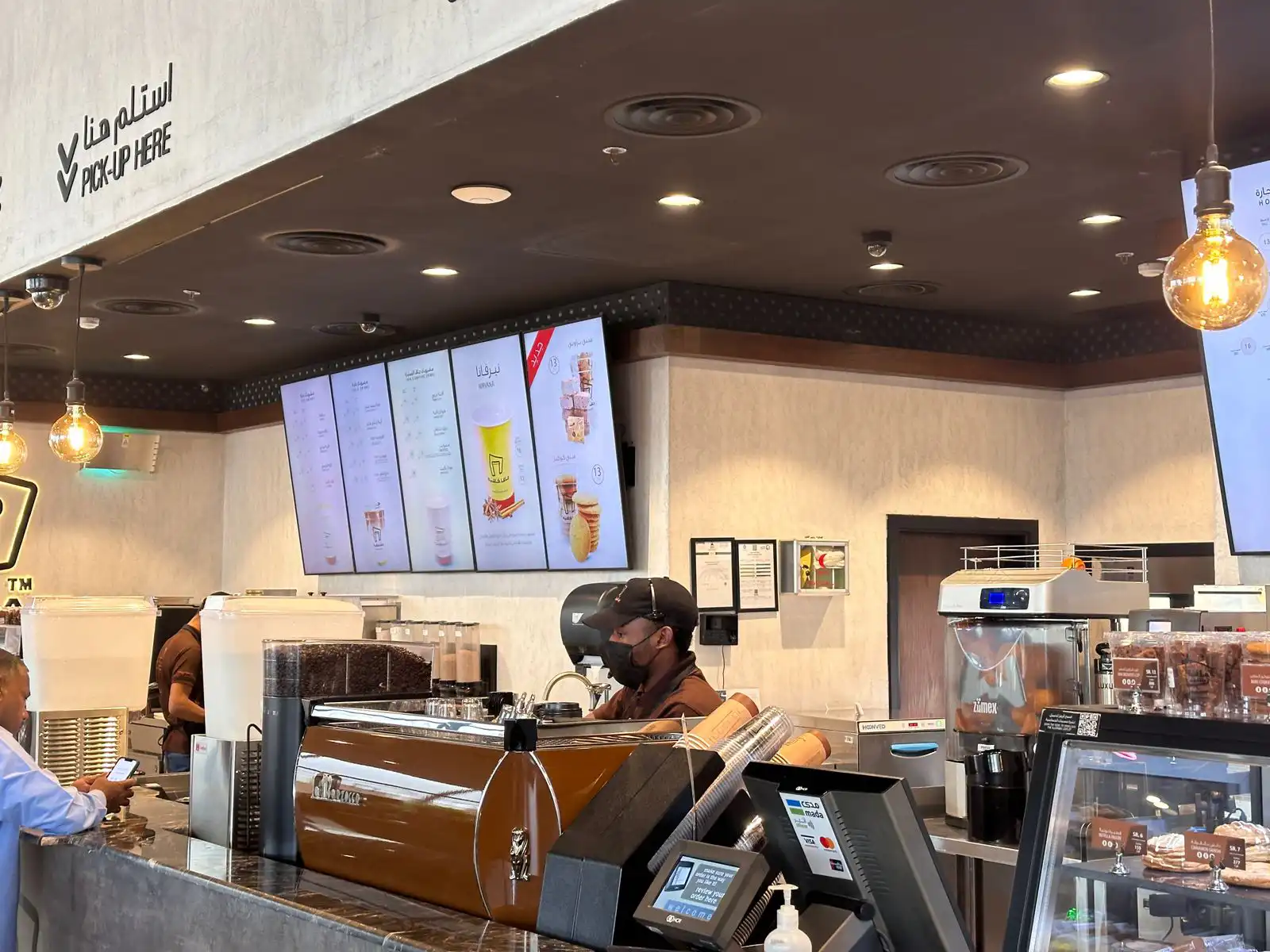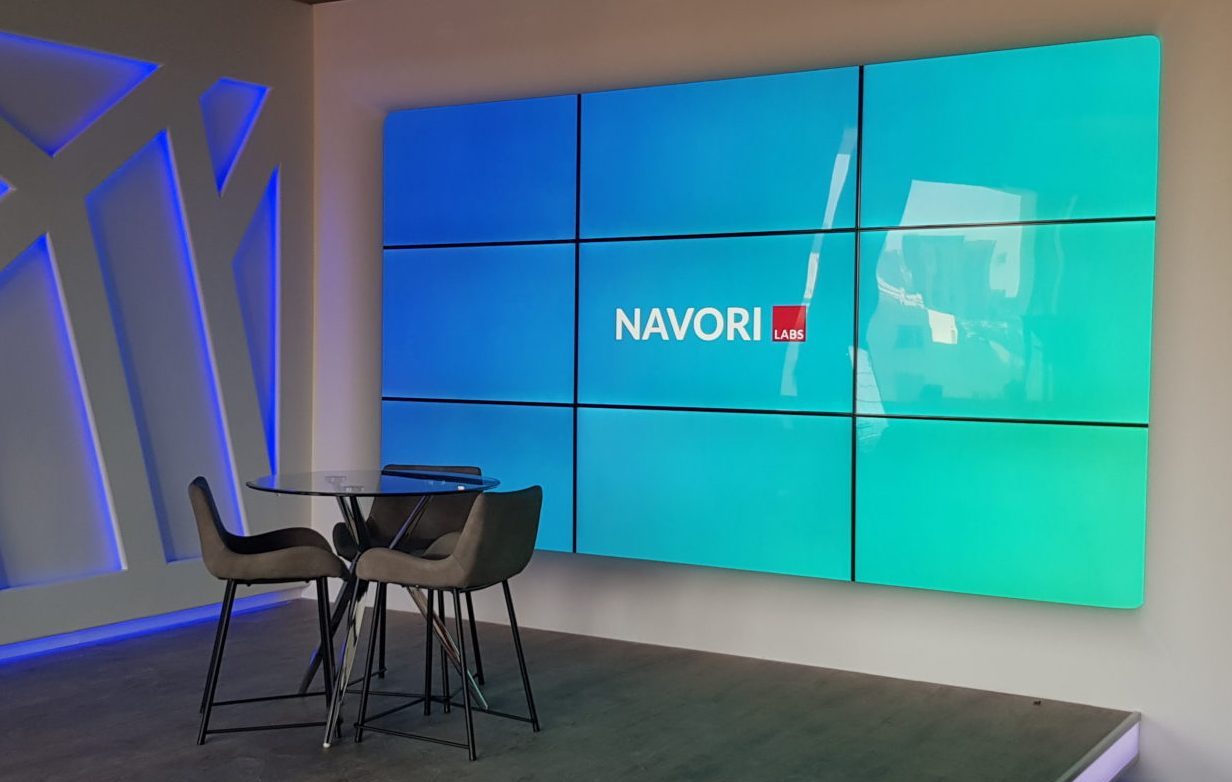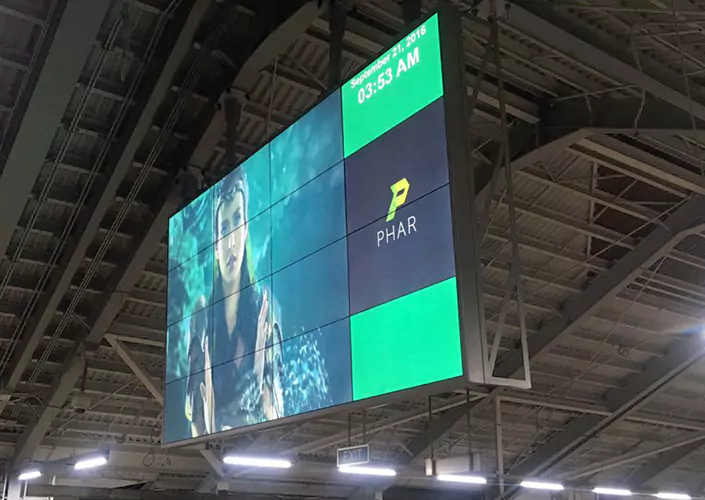How To Unlock the Power of Video Walls and Multi-Screen Signage
About video walls and multiscreen for digital signage
Video walls and multiscreen setups introduces a new dimension of visual engagement and storytelling to any environment. These expansive displays capture attention with their sheer size and immersive content delivery, making them ideal for grabbing the audience’s focus in high-traffic areas such as quick service restaurants, shopping malls, airports, or event venues. By leveraging multiple screens, businesses can create dynamic and captivating visual experiences, by leveraging an enhanced visual impact, leaving a lasting impression on viewers.
Multiscreen set is mainly used to showcase videos, live events, or graphics embedding live data like digital menu boards, business dashboards or live schedules.
Navori App is featuring the ability to divide and display content across multiple screens enabling to convey complex information effectively and efficiently. Multiscreen configurations require highly efficient player software capable of displaying content in ultra-high resolution, synchronizing display with precision to within 1/30th of a second for operations 24x7x365.
Picking the right CMS software for the job
It’s safe to say most CMS products on the market can manage and screen content on single displays. Things get dicey if you start looking for multi-screen capability. Even then, few can easily switch from a single piece of content shown across all displays to individual content on each display. Therefore, you should look for professional-grade video wall software that lets you create flexible layouts with the fewest restrictions.
The best products will let you design digital signage video wall layouts. This enables the content to be assigned to any number of displays, regardless of their orientation, or resolution. You should be able to assign content that spans one or more displays and change layouts easily. Templates should not be difficult to create or update by non-technical users.
Displaying data on your video wall displays
Your digital signage CMS should embed a designer that supports data and graphics overlays. So it’s easy for you to add news feeds, weather information, sports results, financial/ banking information, corporate data, production statistics, and other live data feeds. Your preferred solution should let you position any image, graphic, or text element, anywhere within the multi-screen screen area with as few restrictions as possible. Transparency layers should also be available on your video wall software of choice. This lets you create professional-looking content. For example news tickers or a clock with the current date floating on top of any media displayed on the screen.
Controlling high resolution multi-screen canvas using a multi-Head PC
Many digital signage software products designed for the Windows operating system rely on the PC’s video drivers for screen management. Keeping your video drivers up to date is crucial as video card manufacturers frequently release new features and bug fixes. Once you have installed the hardware and configured the Windows PC, it becomes essential to ensure that the video drivers recognize all connected displays and screen them in the correct order. Otherwise, there may be instances where content appears on the wrong display.
Both Microsoft Windows and video card driver software applications offer features that allow you to check the organization of your displays. If you notice anything suspicious, you can swap out video cables or reorganize the displays using the video driver software until you achieve the desired results.
In certain situations, you may wish to mix screen orientations, such as having two displays in landscape and two in portrait orientation. To support this configuration, you will need a video card with four outputs that can handle mixed orientations. The video drivers should be configured to account for the dimensions of all the displays. Additionally, your digital signage software must support this layout; otherwise, your content may not be displayed correctly. It is crucial for all components to work harmoniously together to ensure proper playback of the content.

Videowall using a single 4K Android player device daisy-chained
This setup allows for simplified cable management and centralized control, as video signals and commands can be transmitted from a single media player device to all screens in the video wall.
A daisy chain for a video wall refers to the method of connecting multiple display screens together in a series, typically using DisplayPort, HDMI. The video output of one screen is connected to the input of the next screen, and so on, creating a chain of displays. Daisy chaining can streamline installation and reduce costs associated with cabling, making it a popular choice for constructing large-scale video walls.
Videowall powered by one synched player device or SoC per screen
Syncing System-on-Chip (SoC) screens for a video wall involves coordinating the display of content across multiple screens that have SoC technology built directly into the display hardware. These screens can be synchronized using Navori player software featuring screen sync to ensure that content is displayed seamlessly across all displays in the video wall.
By syncing SoC screens, businesses can create immersive and visually striking displays that deliver consistent messaging and enhance the overall viewing experience for audiences. This capability is particularly useful for applications such as digital menu boards, and extra large LED displays.

Examples of video wall applications
Restaurant digital menu boards
Digital menu boards are increasingly popular in restaurants and quick-service establishments, serving as dynamic and eye-catching digital menu boards. With video walls, establishments can screen their menu offerings, promotions, and special deals in an engaging and visually appealing manner. The flexibility of digital menu boards allows for easy updates, enabling businesses to showcase new items, adjust pricing, or promote limited-time offers quickly. Video walls in these settings enhance the customer experience, streamline ordering processes, and provide an opportunity for upselling and cross-selling.
Retail environments
Digital signage video walls are a powerful tool for retail environments. They can be used to create immersive brand experiences, showcase product catalogs, and highlight promotions or sales events. By leveraging the large screen area and captivating visuals of video walls, retailers can grab the attention of shoppers, enhance the overall shopping experience, and drive sales.
Corporate Lobbies and Reception Areas
Video walls in corporate lobbies and reception areas make a strong first impression on visitors and guests. They can screen dynamic content such as corporate branding, company announcements, welcome messages, or even showcase the organization’s achievements. Video walls in these areas create a visually stunning and engaging environment, leaving a lasting positive impression on visitors.
Event Venues and Arenas
Video walls play a central role in enhancing the spectator experience at event venues and arenas. They can be used to screen live event footage, instant replays, sponsor advertisements, interactive content, and social media feeds. Video walls in these settings create a vibrant and immersive atmosphere, amplifying the excitement and engagement levels of the audience.
Advantages of a software for video walls and multi-display
Video walls that are built around digital signage technologies represent significant advantages over hardware-based video wall installations.
Reduced costs
Dedicated, hardware-based video wall controllers tend to be much more expensive than digital signage-based systems that use regular PCs with multi-output video cards. With Navori, you can manage up to 16 screens in full HD resolution without requiring a video controller. Your savings will be substantial, and your hardware setup simplified.
Ease of configuration and use
Traditional digital signage software can be relatively easy to use compared to the proprietary interfaces used for hardware-based systems. PCs are also easier to configure and use standard components (RAM memory, hard drives, etc.). PCs don’t require specially trained personnel.
More flexibility
Hardware-based controllers are single-purpose devices so they can only be used for that specific use. PCs can be reconfigured, upgraded, and redeployed very easily.
Ease of maintenance
PC components are easy to source and less expensive to purchase. They can be repaired out in the field where most hardware controllers need to be sent to a specialized shop for repairs.
Hardware considerations
Dedicated hardware-based screen controllers have their purpose. They are essential when designing artistic layouts or when you need to mix displays that have different sizes and image aspects. Hardware screen controllers are also extremely reliable but their high cost relegates them to very specific applications. They are rarely used for basic video wall applications anymore.
The advantages of using digital signage software and PC hardware are obvious. You can operate your digital signage video walls with hundreds of other displays and interactive kiosks using a single technology. You control individual displays, multiple video walls with different layouts, touch enabled displays and other means of content presentation using a common software product.
As PC hardware and video card technologies further evolve, we anticipate hardware based video controllers will become obsolete. It’s just a matter of time before video card manufacturers bridge the gap.
Should you opt for a daisy chain setup, the Stix media player device produced by Navori is perfect. It broadcasts in 4K, which will give you full HD resolution for a video wall of 4 screens.
In the meanwhile, there are plenty of solutions for every project, and every budget.

Best practices for digital signage video walls
Unleashing the full potential of your digital signage video walls requires a strategic blend of artistic finesse and technical expertise. As you embark on this captivating endeavor, consider the following best practices:
Screen Selection
Select high-quality displays with slim bezels, creating a seamless and immersive video wall experience. Opt for screens that offer optimal brightness and contrast, ensuring vibrant and clear content delivery even in well-lit environments.
Thoughtful Content Planning
Strategically plan your content layout to make the most of the video wall’s unique capabilities. Utilize templates or dedicated content management systems like Navori which are tailored for video walls and to streamline content creation and scheduling processes.
Optimize Content
Optimize your content to match the video wall’s resolution and aspect ratio. Utilize high-resolution images and videos to ensure sharp and clear visuals on the larger screen area.
Visual Hierarchy
Create a clear visual hierarchy within your content, placing important information or key messages in prominent positions on the video wall. Utilize larger fonts, bold colors, and visual cues to emphasize critical details and guide viewers’ attention effectively.
Synchronized Content Playback
If your video wall comprises multiple displays, ensure synchronized content playback. Utilize video wall processors or content management systems that support synchronized playback to eliminate visual discrepancies between screens. This synchrony enhances the immersive experience for viewers.
By adhering to these professional best practices, you can elevate your digital signage video walls to new heights. Thoughtful planning, meticulous execution, and ongoing maintenance will result in captivating visual displays that effectively communicate your messages, leaving a lasting impact on your audience.

 Copy link
Copy link